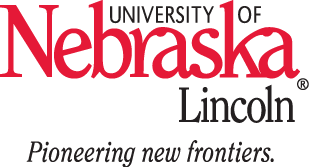Research
Our research focuses on developing NDT and sensing technologies for evaluation of civil infrastructure and construction materials.
Active Research Projects
Online Monitoring System for Concrete Structures Affected by Alkali-Silica Reaction (ASR)
Sponsor: Department of Energy - Nuclear Energy University Porgram (NEUP)PI: Jinying Zhu,
Collaborators:
Paul Ziehl: The University of South Carolina (USC)
Eric Giannini: The University of Alabama (UA)
Ying Zhang : Georgia Institute of Technology (GT)
Vivek Agarwal: Idaho National Laboratory (INL)
Project duration: 10/2016-9/2019
Alkali-silica reaction (ASR) is a chemical reaction in concrete
between certain siliceous minerals and alkali hydroxides in the pore
solution that can lead to expansion and cracking of concrete
structures. ASR has resulted in deterioration and loss of
serviceability of numerous concrete infrastructures, including
transportation, hydraulic, and nuclear power plants (NPP)
structures. Although considerable success has been obtained on
minimizing the risk of ASR in new construction, diagnosis and
evaluation of the extent of damage along with prognosis of the
long-term performance of existing structures remain challenging
topics in research and practice.
Condition Assessment of Bridge Decks with Asphalt Overlay
Sponsor: Nebraska Department of Roads (NDOR)PI: Jinying Zhu, Co-PI: Richard Wood
Project duration: 7/2016-12/2017
Asphalt overlay is a common practice for concrete bridge deck rehabilitation. However, asphalt overlays inhibit visual inspection of concrete bridge deck and limit application of many nondestructive testing (NDT) methods. There was very limited progress in NDT applications to asphalt overlaid bridge decks. The objectives of this project are to evaluate accuracy of GPR evaluation on asphalt overlaid concrete bridge decks, and make recommendations based on laboratory and field testing results. The ultimate goal is to develop evaluation guidelines for asphalt overlaid bridge decks and provide a tool for NDOR to make rehabilitation decisions.
Automated Chain Drag Testing
Sponsor: Nebraska Department of Roads (NDOR)PI: Jinying Zhu
Project duration: 7/2015-12/2016
This research project aims to address the current drawbacks in chain drag test by developing an automated system that integrates sensing, data processing, defect identification algorithms and automated positioning in one testing system. Acoustic signals generated by the dragging chain on concrete will be sensed by acoustic sensors (microphones) and further analyzed and recorded by a computer. Inclusion of a positioning system will enable real time visualization of tested areas and allow engineers to make quick assessment of bridge deck conditions. Data from the test can be saved for further analysis and used for comparison with past and future tests.
Completed Research Projects (Incomplete list)
High Speed Non-Contact NDT of Rail Tracks Using an Innovative Spark Ultrasonic Source and Air-Coupled Transducers
Sponsor: Research Council Faculty Seed Grant, University of NebraskaPI: Jinying Zhu
Project duration: 1/2015-12/2015
This research project aims to address the current challenges in railway inspection by developing a non-contact NDT system to rapidly inspect railway track. A spark ultrasonic source is proposed for exciting ultrasonic waves in steel without contact to the surface; and air-coupled sensors are used as receivers.
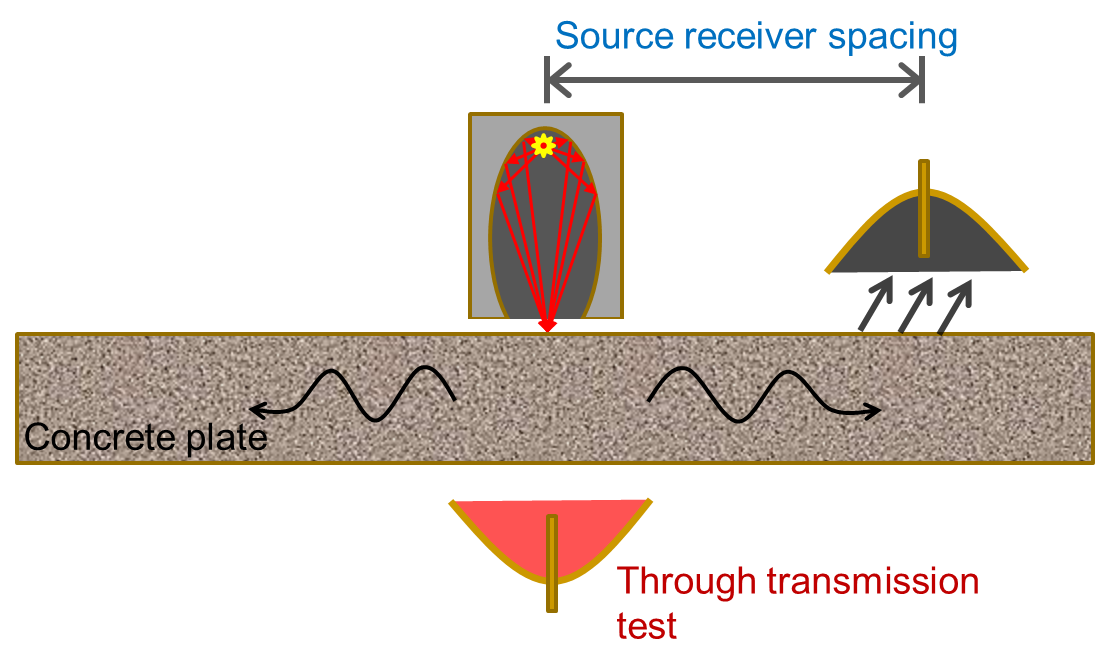 |
Non-contact Acoustic SourceSponsor: National Institute of Standards and Technology (NIST) Technology Innovation Program (TIP) 2010-2014 One of the biggest challenges in fully air-coupled sensing is the low energy transmitted into solids. Most acoustic energy is refelcted at the air-solid interface due to the large acoustic impedance mismatch between air and most solids. Dr. Zhu's research group proposed a focused spark source as a non-contact excitation source for NDT of high impedance materials, such as concrete, metals. A paten derived from this invention has been filed. |
|
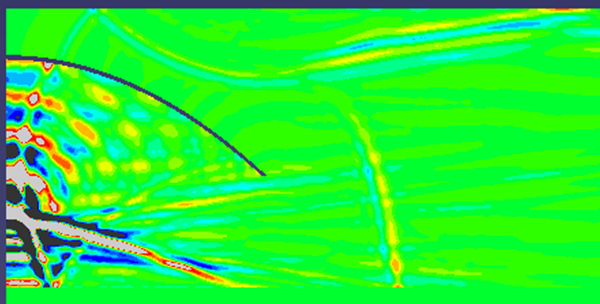 Acoustic
wave field focused by a parabolic reflector. Acoustic
wave field focused by a parabolic reflector. |
Signal Amplification by Acoustic Wave FocusingSponsor: National Institute of Standards and Technology (NIST) Technology Innovation Program (TIP) 2010-2014, to University of Texas Austin One challenge in air-coupled sensing tests is the low signal-to-noise ratio (SNR). The acoustic signals of interest are often contaminated by ambient noises, such as traffic noise in field testing. We proposed a solution to amplify the Impact-echo acoustic signals by applying a parabolic reflector, which amplify the signal amplitue by focusing acoustic energy to the focal point, where the air-coupled sense is located. This concept has been validated in laboratoty and applied to field testing. |
|
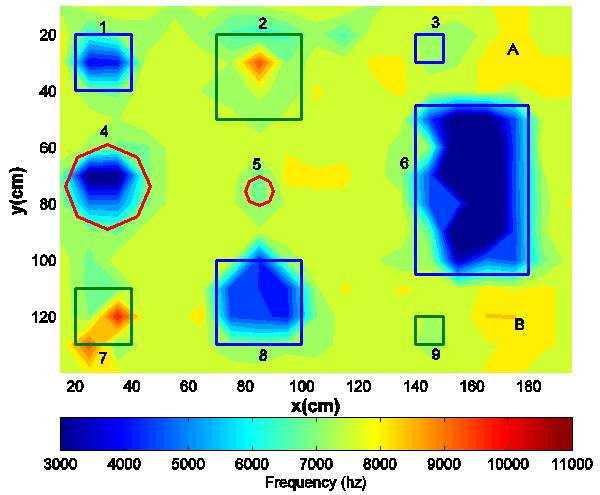 Air-coupled IE test on a concrete specimen with embedded defects. Air-coupled IE test on a concrete specimen with embedded defects.
|
Air-coupled Impact-Echo for ConcreteSponsor: NSF (to University of Illinois at Urbana-Champaign) Project period: 2000-2005 Delaminations in concrete bridge deck and parking garages are commonly caused by corrosion of rebars. The commonly used chain drag test is subjective, and the conventional impact-echo tests are time consuming. Air-coupled sensors enables rapid scanning and testing by eliminating the contact requirement between sensors and concrete surface. |
|
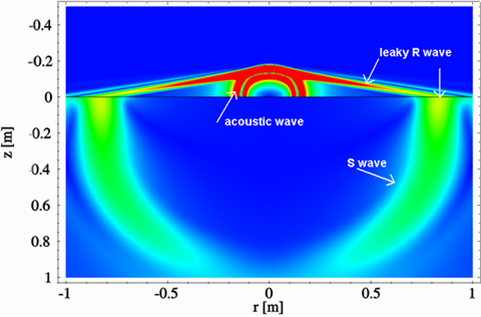 Simulated wavefield in fluid-solid half-space media. |
Propagation of Elastic Waves Along Fluid-Solid InterfaceAnalytical solution and numerical simulations of waves along fluid-solid interface provise solid theoretical background for air-coupled sensing of solids. The leaky Rayleigh wave has highest amplitude among airborn waves excited by a point source. The LR wave has the same velocity and bahavior as the Rayleigh wave propagating along the solid surface. Measuring transmission and velocity of LR wave using air-coupled sensors allow determination of surface breakign crack depth and mechanical properties of the solid. |
|
 |
Monitor Concrete Setting and Hardening Using Shear WavesUltrasonic shear waves are used for monitoring the setting process of fresh concrete. The P wave velocity, although widely used, is affected by air voids in the fluid phase. Shear wave velocity is governed by the solid framework that is formed by hydration products. Our experimental study shows good agreement between shear wave velocity and penetration resistance measurement. This relationship is not affected by w/c, temperature etc. |


